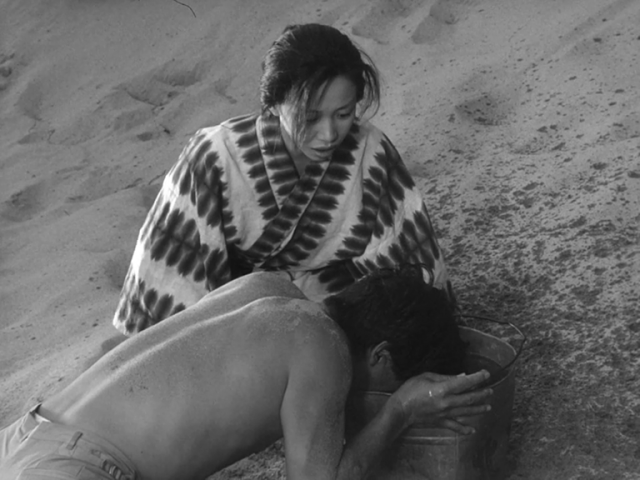WOMAN IN THE DUNES (SUNNA NO ONNA) (Hiroshi Teshigahara, 1964)
MoMA Film, Museum of Modern Art
The Lewis B. and Dorothy Cullman Education and Research Building
4 West 54th St. between Fifth & Sixth Aves.
February 19-21, 1:30
Tickets: $12, in person only, may be applied to museum admission within thirty days, same-day screenings free with museum admission, available at Film and Media Desk beginning at 9:30 am
212-708-9400
www.moma.org
 On an insect-gathering expedition across a vast landscape of desert sand by the ocean, an entomologist (Eiji Okada) suddenly finds himself trapped in a kind of Sisyphean hell in Hiroshi Teshigahara’s Kafka-esque Woman in the Dunes, based on Kōbō Abe’s marvelous novel. The man — his name is given only at the very end — is tricked into moving in with a woman (Kyōko Kishida) who is living in a ramshackle house built deep in a sand dune; the only way out is via a rope ladder that local villagers use to give them their sparse supplies. At first the man thinks it’s all some kind of joke, but as he discovers that there’s no way out — trying to climb the walls of sand just makes more work for him and the woman — he has to reevaluate his surreal situation. Woman in the Dunes is a brutal statement on the futility, desperation, and emptiness of simple human existence. The man is reduced to one of the insects he collects in jars — glass is made of sand, of course — while the woman, whose husband and son died in this ditch, does the cooking and cleaning, their unique identities gone, stripped away by their pointless toil. They are left with seemingly no purpose in life except to serve the strange villagers who occasionally peer down at them as if they were animals in a zoo. “Are you shoveling to survive, or surviving to shovel?” the man asks the woman, who has clearly resigned herself to her fate. Cinematographer Hiroshi Segawa often shoots the black-and-white film in near darkness, the characters virtually disappearing for brief periods of time, while Tōru Takemitsu’s ominous avant-garde score adds to the intensity. Abe and Teshigahara also collaborated on The Pitfall, The Ruined Map, and The Face of Another, but Woman in the Dunes is their masterwork, a shattering look at the meaninglessness of life. The 123-minute version of Woman in the Dunes (there’s also a recently restored 147-minute director’s cut) is screening February 19-21 at 1:30 as part of MoMA’s ongoing series “An Auteurist History of Film,” which continues February 26-28 with Peter Emmanuel Goldman’s Echoes of Silence and March 5-7 with Joseph Losey’s The Servant.
On an insect-gathering expedition across a vast landscape of desert sand by the ocean, an entomologist (Eiji Okada) suddenly finds himself trapped in a kind of Sisyphean hell in Hiroshi Teshigahara’s Kafka-esque Woman in the Dunes, based on Kōbō Abe’s marvelous novel. The man — his name is given only at the very end — is tricked into moving in with a woman (Kyōko Kishida) who is living in a ramshackle house built deep in a sand dune; the only way out is via a rope ladder that local villagers use to give them their sparse supplies. At first the man thinks it’s all some kind of joke, but as he discovers that there’s no way out — trying to climb the walls of sand just makes more work for him and the woman — he has to reevaluate his surreal situation. Woman in the Dunes is a brutal statement on the futility, desperation, and emptiness of simple human existence. The man is reduced to one of the insects he collects in jars — glass is made of sand, of course — while the woman, whose husband and son died in this ditch, does the cooking and cleaning, their unique identities gone, stripped away by their pointless toil. They are left with seemingly no purpose in life except to serve the strange villagers who occasionally peer down at them as if they were animals in a zoo. “Are you shoveling to survive, or surviving to shovel?” the man asks the woman, who has clearly resigned herself to her fate. Cinematographer Hiroshi Segawa often shoots the black-and-white film in near darkness, the characters virtually disappearing for brief periods of time, while Tōru Takemitsu’s ominous avant-garde score adds to the intensity. Abe and Teshigahara also collaborated on The Pitfall, The Ruined Map, and The Face of Another, but Woman in the Dunes is their masterwork, a shattering look at the meaninglessness of life. The 123-minute version of Woman in the Dunes (there’s also a recently restored 147-minute director’s cut) is screening February 19-21 at 1:30 as part of MoMA’s ongoing series “An Auteurist History of Film,” which continues February 26-28 with Peter Emmanuel Goldman’s Echoes of Silence and March 5-7 with Joseph Losey’s The Servant.
